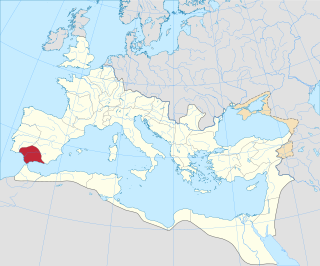
Aedile was an elected office of the Roman Republic. Based in Rome, the aediles were responsible for maintenance of public buildings and regulation of public festivals. They also had powers to enforce public order and duties to ensure the city of Rome was well supplied and its civil infrastructure well maintained, akin to modern local government.
This article concerns the period 29 BC – 20 BC.
Year 197 BC was a year of the pre-Julian Roman calendar. At the time it was known as the Year of the Consulship of Cethegus and Rufus. The denomination 197 BC for this year has been used since the early medieval period, when the Anno Domini calendar era became the prevalent method in Europe for naming years.

Marcus Porcius Cato, also known as Cato the Censor, the Elder and the Wise, was a Roman soldier, senator, and historian known for his conservatism and opposition to Hellenization. He was the first to write history in Latin with his Origines, a now fragmentary work on the history of Rome. His work De agri cultura, a rambling work on agriculture, farming, rituals, and recipes, is the oldest extant prose written in the Latin language. His epithet "Elder" distinguishes him from his great-grandson Cato the Younger, who opposed Julius Caesar.

Hispania Tarraconensis was one of three Roman provinces in Hispania. It encompassed much of the northern, eastern and central territories of modern Spain along with modern northern Portugal. Southern Spain, the region now called Andalusia, was the province of Hispania Baetica. On the Atlantic west lay the province of Lusitania, partially coincident with modern-day Portugal.

Publius Cornelius Scipio Nasica was a consul of ancient Rome in 191 BC. He was a son of Gnaeus Cornelius Scipio Calvus.

Hispania Baetica, often abbreviated Baetica, was one of three Roman provinces in Hispania. Baetica was bordered to the west by Lusitania, and to the northeast by Hispania Tarraconensis. Baetica remained one of the basic divisions of Hispania under the Visigoths down to 711. Baetica was part of Al-Andalus under the Arabs in the 8th century and approximately corresponds to modern Andalusia.
Gaius Laelius was a Roman general and statesman, and a friend of Scipio Africanus, whom he accompanied on his Iberian campaign and his African campaign. His command of the Roman fleet in the attack on New Carthage and command of the Roman cavalry at Zama contributed to Scipio's victories.

Tarraco is the ancient name of the current city of Tarragona. It was the oldest Roman settlement on the Iberian Peninsula. It became the capital of Hispania Tarraconensis following the latter's creation during the Roman Empire.

Marcus Claudius Marcellus was the eldest son of Gaius Claudius Marcellus and Octavia Minor, sister of Augustus. He was Augustus' nephew and closest male relative, and began to enjoy an accelerated political career as a result. He was educated with his cousin Tiberius and traveled with him to Hispania where they served under Augustus in the Cantabrian Wars. In 25 BC he returned to Rome where he married his cousin Julia, who was the emperor's daughter. Marcellus and Augustus' general Marcus Vipsanius Agrippa were the two popular choices as heir to the empire. According to Suetonius, this put Agrippa at odds with Marcellus, and is the reason why Agrippa traveled away from Rome to Mytilene in 23 BC.

Hispania Ulterior was a Roman province located in Hispania during the Roman Republic, roughly located in Baetica and in the Guadalquivir valley of modern Spain and extending to all of Lusitania and Gallaecia. Its capital was Corduba.

Hispania Citerior was a Roman province in Hispania during the Roman Republic. It was on the eastern coast of Iberia down to the town of Cartago Nova, today's Cartagena in the autonomous community of Murcia, Spain. It roughly covered today's Spanish autonomous communities of Catalonia and Valencia. Further south was the Roman province of Hispania Ulterior, named as such because it was further away from Rome.

The Turdetani were an ancient pre-Roman people of the Iberian Peninsula, living in the valley of the Guadalquivir, in what was to become the Roman Province of Hispania Baetica. Strabo considers them to have been the successors to the people of Tartessos and to have spoken a language closely related to the Tartessian language.
Quintus Fulvius Flaccus was a plebeian consul of the Roman Republic in 179 BC. Because of his successes in Spain and Liguria, he celebrated two triumphs. Although his political career was a success, he was plagued by controversy and suffered a mental breakdown that culminated in suicide.
Gaius Flaminius was Roman consul in 187 BC, together with Marcus Aemilius Lepidus. During his consulship, he fought to pacify Ligurian tribesmen who had been raiding northern Italy.
Titus Didius was a politician and general of the Roman Republic. In 98 BC he became the first member of his family to be consul. He is credited with the restoration of the Villa Publica, and for his command in Hispania Citerior. He held two Triumphs, one for his victories over the Scordisci, another for his victories in Spain.
Quintus Fabius Maximus was a general and politician of the late Roman Republic who became suffect consul in 45 BC.
Quintus Minucius Thermus was a Roman statesman and military commander.
This section of the timeline of Hispania concerns Spanish and Portuguese history events from the Carthaginian conquests to before the barbarian invasions.
The gens Helvia was a plebeian family at ancient Rome. This gens is first mentioned at the time of the Second Punic War, but the only member of the family to hold any curule magistracy under the Republic was Gaius Helvius, praetor in BC 198. Soon afterward, the family slipped into obscurity, from which it was redeemed by the emperor Pertinax, nearly four centuries later.








